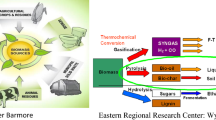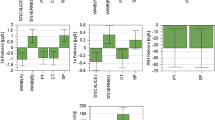Abstract
Hydrothermal carbonization (HTC) of wheat straw digestate was performed at 180–260 °C for 2–8 h. The resulted hydrochars were analyzed by ultimate analyzer. Elemental carbon and oxygen concentration of hydrochars were fitted with power law correlation. Moreover, chemical structures of feedstocks and hydrochars were investigated by 13C cross-polarization magic angle spinning (CP/MAS) nuclear magnetic resonance (NMR) spectroscopy. In particular, a procedure including CP dynamics analysis was applied to obtain semi-quantitative information on the composition of the analyzed materials from 13C CP/MAS spectra. Up to a process temperature of 220 °C, digestate-derived hydrochar contained primarily crystalline cellulose and lignin. At 260 °C, crystalline cellulose was degraded and more aliphatic carbon and lignin-rich hydrochars were produced. Ester bands corresponding to hemicellulose disappeared at mild HTC conditions at 180 °C and 2 h.




Similar content being viewed by others
References
Hendriks ATWM, Zeemann G (2009) Pretreatments to enhance the digestibility of lignocellulosic biomass. Bioresour Technol 100:10–18
Funke A, Mumme J, Diakite M (2013) Cascaded production of biogas and hydrochar from wheat straw: energetic potential and recovery of carbon and plant nutrients. Biomass Bioenergy 58:229–237
Nkoa A (2014) Agricultural benefits and environmental risks of soil fertilization with anaerobic digestates: a review. Agron Sustain Dev 34:473–492
Berge ND, Ro KS, Mao J, Flora JRV, Chappell MA, Bae S (2011) Hydrothermal carbonization of municipal waste streams. Environ Sci Technol 45:5696–5703
Goto M, Obuchi R, Hirose T, Sasaki T, Shibata M (2004) Hydrothermal conversion of municipal organic waste into resources. Bioresour Technol 93:279–284
Mumme J, Eckervogt L, Pielert J, Diakité M, Rupp F, Kern J (2011) Hydrothermal carbonization of anaerobically digested maize silage. Bioresour Technol 102:9255–9260
Reza MT, Werner M, Pohl M, Mumme J (2014) Evaluation of integrated anaerobic digestion and hydrothermal carbonization for bioenergy production. J Vis Exp 88:1–9
Reza MT, Borrego A, Wirth B (2014) Optical texture of hydrochar from maize silage and maize silage digestate, Int. J Coal Geol 134–135:74–79
Dicke C, Lanza G, Mumme J, Ellerbrock R, Kern J (2014) Effect of HTC-char application on trace gas emissions from two sandy soil horizons. J Environ Qual 43:1790–1798
Reza MT, Uddin MH, Lynam JG, Hoekman SK, Coronella CJ (2014) Hydrothermal carbonization: reaction chemistry and water balance. Biomass Conv Bioref 4:311–321
Reza MT, Becker W, Sachsenheimer K, Mumme J (2014) Hydrothermal carbonization (HTC): Near infrared spectroscopy and partial least-squares regression for determination of selective components in HTC solid and liquid products derived from maize silage. Bioresour Technol 161:91–101
Reza MT, Lynam JG, Vasquez VR, Coronella CJ (2014) Engineered pellets from hydrothermally carbonized and torrefied biochar blend. Biomass Bioenergy 63:229–238
Reza MT, Andert J, Wirth B, Busch D, Pielert J, Lynam JG et al (2014) Hydrothermal carbonization of biomass for energy and crop production. App Bioenerg 1:11–28
Reza MT, Wirth B, Lüder W, Werner M (2014) Behavior of selected hydrolyzed and dehydrated products during hydrothermal carbonization of biomass. Bioresour Technol 169:352–361
Sevilla M, Fuertes AB (2009) The production of carbon materials by hydrothermal carbonization of cellulose. Carbon 47:2281–2289
Calucci L, Rasse DP, Forte C (2012) Solid-state nuclear magnetic resonance characterization of chars obtained from hydrothermal carbonization of corncob and miscanthus. Energ Fuel 27:303–309
Cao X, Ro K, Chappell M, Li Y, Mao J (2011) Chemical structures of swine-manure chars produced under different carbonization conditions investigated by advanced solid-state 13C nuclear magnetic resonance (NMR) spectroscopy. Energ Fuel 25:388–397
Pohl M, Mumme J, Heeg K, Nettmann E (2012) Thermo- and mesophilic anaerobic digestion of wheat straw by the upflow anaerobic solid-state (UASS) process. Bioresour Technol 124:321–327
Boie W (1953) Fuel technology calculations. Energietechnik 3:309–316
Grénman H, Eränen K, Krogell J, Willför S, Salmi T, Murzin DY (2011) The kinetics of aqueous extraction of hemicelluloses from spruce in an intensified reactor system. Ind Eng Chem Res 50:3818–3828
Reza MT, Uddin MH, Lynam JG, Coronella CJ (2013) Hydrothermal carbonization: fate of inorganics. Biomass Bioenergy 49:86–94
Reza MT, Uddin MH, Lynam JG, Hoekman SK, Coronella CJ, Vasquez VR (2013) Reaction kinetics and particle size effect on hydrothermal carbonization of loblolly pine. Bioresour Technol 139:161–169
Oliveira I, Blöhse D, Ramke HG (2013) Hydrothermal carbonization of agricultural residues. Bioresour Technol 142:138–146
Becker R, Dorgerloch U, Helmis M, Mumme J, Diakité M, Nehls I (2013) Hydrothermally carbonized plant material: patterns of volatile organic compounds detected by gas chromatography. Bioresour Technol 130:621–628
Peterson AA, Vogel F, Lachance RP, Fröling M, Antal MJ (2008) Thermochemical biofuel production in hydrothermal media: a review of sub- and supercritical water technologies. Energy Environ Sci 1:32–65
Lu X, Pellechia PJ, Flora JRV, Berge ND (2013) Influence of reaction time and temperature on product formation and characteristics associated with the hydrothermal carbonization of cellulose. Bioresour Technol 138:180–190
Kruse A, Badoux F, Grandl R, Wüst D (2012) Hydrothermal carbonization: 2. Kinetics of draff conversion. Chem Ing Tech 84:509–512
Ruyter HP (1982) Coalification model. Fuel 61:1182–1187
Zhang B, Huang H, Ramaswamy S (2008) Reaction kinetics of the hydrothermal treatment of lignin. Appl Biochem Bioethanol 147:119–131
Funke A, Ziegler F (2010) Hydrothermal carbonization of biomass: a summary and discussion of chemical mechanisms for process engineering. Biofuel Bioprod Biorefin 4:60–77
Baccile N, Laurent G, Babonneau F, Faylon F, Titirici MM, Antonietti M (2009) Structural characterization of hydrothermal carbon spheres by advanced solid-state MAS 13C NMR investigations. J Phys Chem 113:9644–9654
Falco C, Caballero FP, Babonneau F, Gervais C, Laurent G, Titirici MM, Baccile N (2011) Hydrothermal carbon from biomass: structural differences between hydrothermal and pyrolyzed carbons via 13C solid state NMR. Langmuir 27:14460–14471
Liu ZG, Quek A, Hoekman SK, Balasubramanian R (2013) Production of solid biochar fuel from waste biomass by hydrothermal carbonization. Fuel 103:943–949
Nonaka M, Hirajima T, Sasaki K (2011) Upgrading of low rank coal and woody biomass mixture by hydrothermal treatment. Fuel 90:2578–2584
Diakité M, Paul A, Jaeger C, Pielert J, Mumme J (2013) Chemical and morphological changes in hydrochars derived from microcrystalline cellulose and investigated by chromatographic, spectroscopic and adsorption techniques. Bioresour Technol 150:98–105
Cao X, Ro KS, Libra J, Kammann C, Lima I, Berge N, Li L, Li Y, Chen N, Yang J, Deng B, Mao J (2013) Effects of biomass types and carbonization conditions on the chemical characteristics of hydrochars. J Agric Food Chem 61:9401–9411
Gajic A, Ramke HG, Hendricks A, Koch HJ (2012) Microcosm study on the decomposability of hydrochars in a Cambisol. Biomass Bioenergy 47:250–259
Wood BM, Jader LR, Schendel FJ, Hahn NJ, Valentas KJ, McNamara PJ, Novak PM, Heilmann SM (2013) Industrial symbiosis: corn ethanol fermentation, hydrothermal carbonization, and anaerobic digestion. Biotechnol Bioeng 110:2624–2632
Acknowledgments
This research is supported by funds from the Bioenergy 2021 program delegated from the German Federal Ministry of Research and Education to Project Management Juelich (PtJ). The corresponding author also acknowledges Western Sun Grant Initiatives (grant no: C0432G-C) for financial support. Additionally, the authors would like to thank E. Janiszewski, G. Rehde, A. Kohl, and O. Haase for their support in analytical tasks.
Author information
Authors and Affiliations
Corresponding author
Additional information
Highlights
•.Wheat straw digestate was hydrothermally carbonized at various conditions.
•.Elemental carbon and oxygen in digestate-derived hydrochar follow power law.
•.13C CP/MAS NMR can be applied for semi-quantitative characterization of hydrochar.
Rights and permissions
About this article
Cite this article
Reza, M.T., Mumme, J. & Ebert, A. Characterization of hydrochar obtained from hydrothermal carbonization of wheat straw digestate. Biomass Conv. Bioref. 5, 425–435 (2015). https://doi.org/10.1007/s13399-015-0163-9
Received:
Revised:
Accepted:
Published:
Issue Date:
DOI: https://doi.org/10.1007/s13399-015-0163-9




